#do it! is inspired by Elisabeth (1992)
Explore tagged Tumblr posts
Text






Lots of poorly drawn Maximilien and frev-bad-takes-scribbles; the history is probably all wrong hahaha
Maxolotl is credited to the brilliant Janelle
#In a weird way I enjoy how Lrf made SJ into the EvilGirlTM in T. Swift’s MVs.#do it! is inspired by Elisabeth (1992)#where der tod goes ‘Tu es!’ in a very sexy way#frev#louis antoine de saint just#maximilien robespierre
346 notes
·
View notes
Text
Comparing Elisabeth's costumes in the Vienna productions of Elisabeth das musical (Act 1)
And I'm back once again to perhaps prove a point, but mainly to pour out some of the frustration. In this post, I'll be comparing the costumes chronologically worn by Elisabeth in the Vienna productions of Elisabeth: the original/1st revival (designed by Reinhard Heinrich; lower refered to as the Heinrich version) and the 2nd revival/Schönbrunn concert (designed by Yan Tax; lower refered to as the Tax version). The Yan Tax design was first used in the 2001 Essen production, but was later carried over into the 2nd revival Vienna production in 2012 and VBW kept on using it since.
I tried to mainly find higher quality photos of all these costumes, but sometimes, I had no luck in doing that. So, at times, I will use a screenshot because nothing else was available. I mainly tried to look for pictures of the 1st revival (circa 2003-2005) and 2nd revival (circa 2012 - 2013), but I will sometimes use pictures from the original production (1992-1996).
Disclaimer: the contents below are my subjective opinion as a student of set and costume design and I will be mainly looking at what the costume tells me within the context and the construction. If you prefer costumes I don't, your opinion is totaly valid and you're welcome to discuss why you think otherwise in reblogs and comments below. :) After each section, I'll try to sum up which of the costumes I liked better and why.
Little Sisi:
Heinrich version: light blue and white trachten/dirndl with a lace apron, hair bow and ribbon choker. Not only fitting her origin as a Bavarian princess, but also sweet with the pastel colors and the accordingly fluffy, but light construction. The costume is girly, but not hindering when is comes to Sisi climbing trees and other physical activities she mentions she likes.
Tax version: short green/brown/orange plaid print dress. Now, this is a historically plausible costume, but do I like it? Absolutely not. The colors and print are ugly and don't fit Sisi's character in the slightest. And with the way the costume has multiple ruffles and pleats, it just makes it too busy to look at. And the skirt is too fluffy for this point in the show. (And they did Abla absolutely dirty with the wig they gave her in 2022 Schönbrunn)
Which is better? Heinrich version all the way. It's sweet and girly, but not too much and I love that it's a trachten/dirndl. The Tax version is just too busy with the plaid and I don't like the colors.
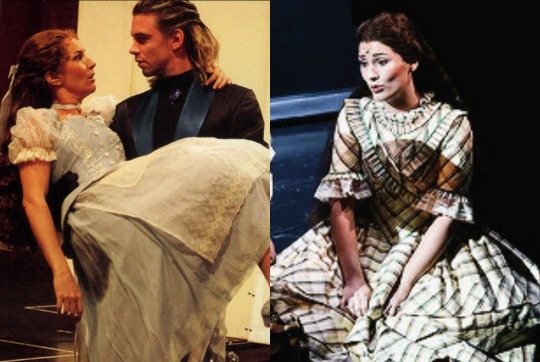
Bad Ischl:
Heinrich version: Dark blue short-sleeved bodice and skirt, matching hair bow and velvet ribbon long choker and bracelets. This costume is directly inspired by what Elisabeth could have worn during this first meeting in Ischl (when she met Franz, she and all her family were in dark mourning dresses, since they didn't have time to change and unlike Helene, who looked washed out in her dark dress, the dark dress really suited Elisabeth). Another little interesting historical detail I noticed here is the choker, which looks like a ribbon choker Elisabeth was mostly depicted wearing during her engagement to Franz. So, awesome that they kept in these little historical details.
Tax version: Long-sleeved bodice and skirt. Now, I've seen this dress in a ton of different fabrics (white with a broad floral trim on the skirt, blue plaid) but I think the most common variant of this costume is this beige one with the orange-red and green pattern. Now, once again, this is a historically more plausible costume, since the meeting took place during the day and so it would be proper for Elisabeth to be covered up, but it doesn't take into account any of the historical happenings. Which just seems to me like the designer didn't do any background research into Elisabeth specifically. And if we're going on pure aesthetic level alone, this dress is so plain and boring.
Which is better? Once again, Heinrich won this. No question needed. And while we're at it, the colorplay the dark dress on Elisabeth offers in Nichts ist schwer is much better that the light dress (We're about to get into lighting here, because that is also important to consider). With the reddish and blue lights for this scene, the dark dress stands out against that very red Habsburg eagle, but the light dress gets a red/pink wash from the lights, which makes Elisabeth almost visually disappear in that scene (see image below). The entire colorplay in the Tax version is simply off for this scene (because the thing that most stands out to me isn't Elisabeth, it's Franz's VERY green knitted socks).

Wedding dress:
Heinrich version: white satin bodice and skirt with silvery translucent overlay, ruffled bertha collar with beaded fringe and puffed translucent sleeves. The amount of soft texture this dress has under the stage lights is so amazing and I really like the choice of sleeve here, since it does remind me of the puffed sleeves she had on her trachten, but this is like a more grown up version. And since the sleeves are translucent and long, it gives Elisabeth the appearance of not fitting in with the court ladies, who all have short sleeves in opaque fabrics . The silvery contrasts look great and the way that white fringe looks like the fringe on Tod's jacket from the Prolog (thus connecting them visually) is *chef's kiss*.
Tax version: white satin button-up bodice with pagoda sleeves and skirt with striped accents. This dress is giving me a whole lot of nothing. Like, there isn't anything eyecatching here. And it makes Elisabeth look kinda dowdy with how covered up she is. And, if they were going for more "historical accuracy", why then put her in a dress that could be classified as daywear (with the long sleeves and the very prominent buttons in the front) if all of the wedding should be taking place in the evening?
Which is better? Heinrich version. The Tax version is too flat and plain for me. If the Heinrich design is proving anything so far, it's that historical accuracy can easily be beaten out with good and purposeful artistic design.
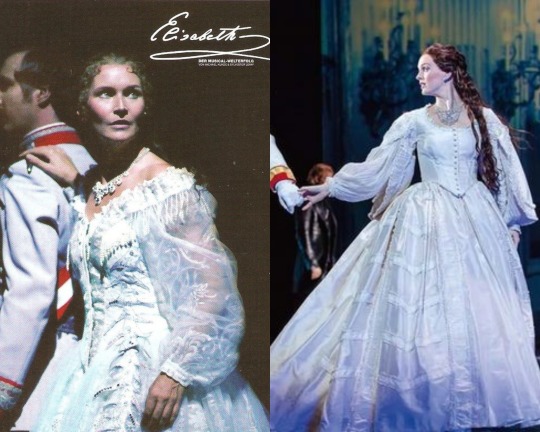
Nightgown:
Heinrich version: structured white nightgown with a slightly raised waistline, broad lace straps and lace trim. Once again, I love the structure the fabric has, it looks soft and romantic under the stage lights. The straps are so characteristic and they make her arms completely bare, thus making her appear vulnerable when facing Sophie and the ladies in waiting.
Tax version: white satin empire waist nightgown with short puffed sleeves. They literally couldn't have picked a thinner and cheaper looking satin for this costume? It literally looks so flimsy, especially since this costume has no texture and no decoration going on. I think the very high empire waistline is also a rather off choice, since it would be very out of fashion during the 1850s and it is a waist placement that often looks awkward on a lot of people. And there are the sleeves. They are very awkwardly short. Especially on the concert costumes, the sleeves literally look like they have 2 cm of an inseam at best.
Which is better? I think this is no surprise, but Heinrich once again gets it.
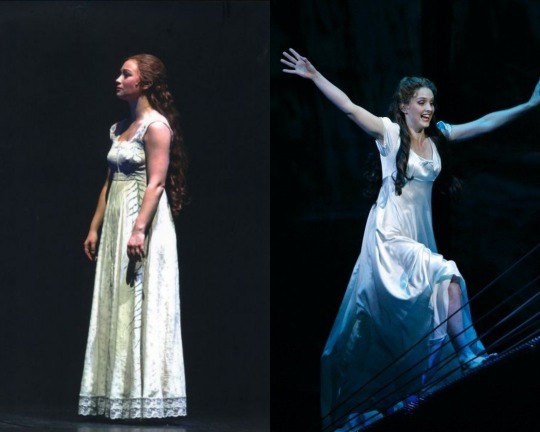
Stationen eine Ehe:
Heinrich version: White robe with ruffled lace trimmings, long bell-shaped sleeves and a broad light blue sash at the waist. I always love when I see a good nightrobe on stage and this is no exception. The material is delicate and translucent enough to keep Elisabeth looking very vulnerable in this scene, even though she's covered up. And the amount and placement of ruffling is just right. What I also find very interesting is that sash, because that color is so eyecatching (reminds me of a robin's egg) and it really gives the robe a distinct look.
Tax version: Reddish-pink duochrome satin bodice with fake buttons and pagoda sleeves w/ white puffed undersleeves and a matching skirt worn over a circular hoopskirt. Once again, more historically plausable, but it doesn't offer me anything as a costume. By making Elisabeth's silhouette here the same as Sophie and the ladies in waiting and by not giving the fabric any sort of softening embellishments, it removes this vulnerability she should have here. And I don't get why they went for this weird pink shade, because it makes no storytelling sense. And while we're at it, why did they choose to put her in this braided wig here? In real life portraiture, we don't get Elisabeth depicted with her hair in these braided updos up until the mid 1860s. The Heinrich version cleverly went around this by keeping Elisabeth with long loose curls through Act 1 to emphasize her girlishness and naivity, so when we see her with her hair braided up in the portrait reveal, it's this clear visual breaking point for her, showing us how she matured. But in the Tax version, it's a mess when it comes to wigs.
Which is better? Once again, Heinrich takes the cake. I feel like I might be biased, but I just can't find any rhyme and reason in the Tax costumes so far.

Schatten Hungarian dress:
Heinrich version: black and dark blue striped satin bodice with a fake stomacher and puffed sleeves and skirt with a black lace apron. For how little time this costume gets on stage, it is so crucial in this design, since it is both a visual paralel with Elisabeth's Hungarian coronation gown (but here, the silhouette is less mature and it's like a dark version of that dress), but also, this dress is paralelled again in the Mayerling dresses, since Shatten in Act 1 and Mayerling are paralel scenes, where Death takes away one of Elisabeth's children because of her unadvised decisions.
Tax version: same dress as in Stationen eine Ehe, but over it is worn a red velvet atilla with gold cording and brown fur trim and a matching red velvet hat. The atilla looks decently made and the cording does seem ok. This is a much technically easier way how to do this quick costume change, but it's ok. What I don't like here is the hat. It simply looks awkward witch the placement of where it's sitting and that cord in the front doesn't make it better. And once again, I am missing the paralels!
Which is better? I will probably sound like I'm repeating myself, but Heinrich version wins again. You can never beat good paralels and visual connections in costume design.

Elisabeth, mach auf mein Engel:
Heinrich version: Same robe as during Stationen eine Ehe (but this time with a better picture). Still love it here, because this is still supposed to be a vulnerable moment (especially when Death comes in at the end). So by keeping her in this nightgown, which she previously wore at a vulnerable moment, we have an immediate connection of how she feels.
Tax version: White chiffon robe with elbow length sleeves w/ lace engageants and with a train trimmed with lace ruffles, worn over a long pale pink/peach/orange?? satin slip. And we have a dreaded return of that flimsy satin! The nightgown for the most part looks ok, but another of this production's big issues comes in here and that is a gaping issue on front closing overcostumes. (If you read my 2022 Schönbrunn roast, you might remember how I complained about the massive amount of gaping in the front Der Tod's doctor disguise had). Here, the gaping could have easily been fixed with an added ruffle along the seam.
Which is better? Heinrich once again.

Star dress:
Heinrich version: Cream bodice with gathered tulle overlay, bertha collar trimmed with pearls and 3 tiered tulle ruffle sleeves, matching skirt with draped tulle overlay, tulle sash and pearl necklace. I love how this dress isn't an outright copy of the Winterhalter portrait, but keeps the soft, etherial and dreamy vibe the dress has. This dress looks light as a feather and even if it doesn't outright have stars, it has a light shimmer in the tulle.
Tax version: Cream bodice decorated with tulle overlay w/ gold embroidered stars, with pleated bertha collar, single tier tulle ruffle sleeves, matching skirt, matching star embroidered shawl, white satin gloves and star necklace. I love how this costume looks exactly like the portrait! The design is great, but sometimes, there have been some hiccups with the execution, specifically with balancing the volume of the sleeve in relation to the skirt. The costume below is one of the better ones, but often, the sleeves end up being too big and the skirt too narrow, throwing the proportion off. And sometimes, the costume can end up looking too stiff.
Which is better? Depending on the version. For me, this will be a tie. The better versions of the Tax design are equally as good as the Heinrich versions. However, if I were to take into account some of the stiffer versions of the Tax design, Heinrich would take the win again.

#elisabeth das musical#emperess elisabeth of austria#costume design#costume analysis#I invite everyone to tell me their opinions in tags#part 2 coming soon
57 notes
·
View notes
Text
Woodcuts in suburbia: melancholy, nostalgia, and resistance
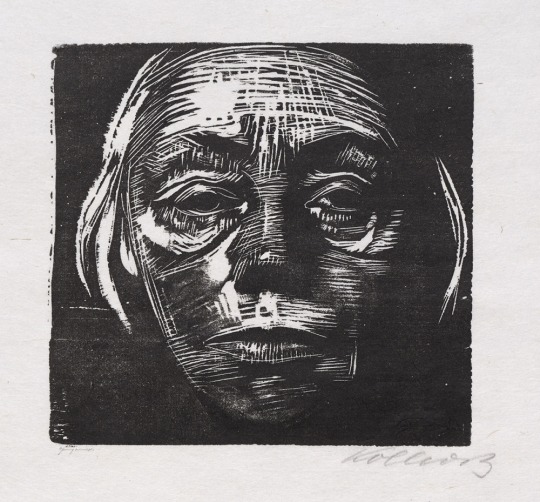
Selbstbildness von vorn, Käthe Kollwitz © 2019 Artists Rights Society (ARS), New York / VG Bild-Kunst, Bonn
I associate woodcuts with a particular aesthetic: they loom from their perch on the bookshelf in the den, next to a collection of Hans Christian Andersen tales, whose worn buckram binding is effusing that sapid antique book aroma which pairs so well with coffee and cake. In the corner of the room, above a worn black leather chair designated for tv-watching and reading, a pathos dangles from its pot, fed by gentle streams of light emanating from the canopy of shade sheltering the backyard garden. On weekends and special occasions, the clinking of cake forks against china is punctuated only by an occasional “delicious!” — direct and accurate. This orchestration produces a distinctly Germanic affect, and one that I associate with the elderly; the particular family room I’m recalling belonged to my next-door neighbors growing up, former members of the Danish anti-Nazi resistance who had emigrated in the early 1960s. While I can’t be sure there was any deeper meaning behind their affinity for the humble woodcut, I do recall the medium’s prominence in their home. For me, something as benign as a flock of geese is represented with a degree of melancholy in these prints' impenetrable black shadows — an inevitability in this generation’s Weltanschauung, that everything beautiful carries with it a degree of pain, a nostalgia for the idea of a more civil world.
These beloved octogenarians were my first choice of role models, and I insisted on seeing them almost every day for the first 8 or 9 years of my life. They were old-school Democrats (or at least, that’s how their values system translated into American) in a largely Republican suburb of a mid-sized Upper Midwestern city. I can still place myself their 1950′s minimal traditional home: running my hands along their walnut furniture with polished nickel handles, greeted by a different antique clock in every room, tick-tocking at various registers, my slippered feet shuffling along a dull, greenish-blue carpet so typical of that era. Nothing in that home was remotely as paired down as today’s sanitized mid-century throwback, and the old neighborhood still retained a smidgen of character unlike contemporary expressions of manifest destiny. Lovingly tended beds of roses, pansies, and bleeding hearts flourished under the shade of maples, walnuts, and red oak.
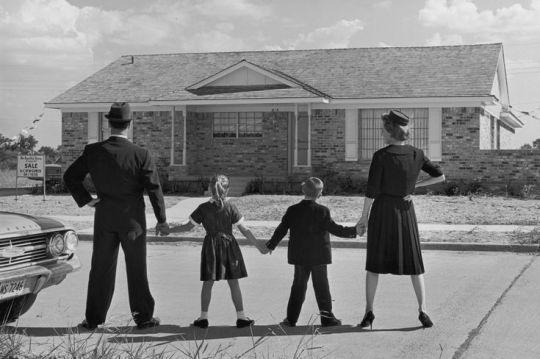
A young family admires their new home. Between 1950 and 1970, America’s suburban population nearly doubled to 74 million Camerique Archive / Archive Photos / Getty Images
For my neighbors, woodcuts seemed to be a culturally relevant way of displaying eerie alternative landscapes: a flock of geese, a school of fish, a sunset laden with a certain degree of subconsciously expressed Weltschmerz. For me, these woodcuts were inextricably linked to their stories of brazen defiance in the face of terror, which they seldom shared, always with a degree of pain and even embarrassment. Their democratic ideals to which they so proudly clung were the real source of their identity; it was from them that I learned it was OK to be gay, that everyone deserved a home and access to healthcare, that one lives like a society like a neighbor rather than just an individual. But it wasn’t until years after their deaths that I detected any degree of paradox in their suburban American existence, was able to chuckle at their nostalgia for the old country as expressed in their grocery cart (tubs of frozen Coolwhip to be served generously with home-baked apple cake, slices of summer sausage or cucumbers served on squares of cocktail rye, a far cry from the bakeries and delicatessens of northern Europe.)
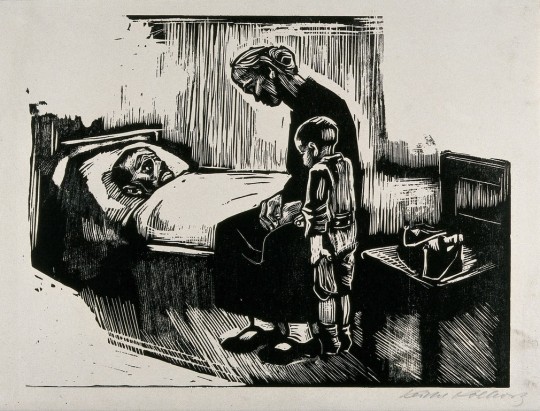
A woman and a boy visiting a man in hospital. Woodcut by Käthe Kollwitz, 1929. Credit: Wellcome Collection. CC BY
While I may associate woodcuts with the interior design choices of an immigrant family in the middle of the last century, its origins predate my concept of history. Woodcutting is thought to be the earliest print technique, originating in 9th-century China, arriving in Europe sometime in the 14th century. Woodcut has been a staple medium for prominent Northern European artists like Dürer since the 16th century. To produce a print, artists carve their image into a block of wood, along the grain, removing the parts that will not carry ink. The surface is then rolled over with a brayer and the image transferred to a sheet of paper through a press. The result in works like Käthe Kollwitz’s Selbstbildness von vorn (1922-1923), pictured above, is nothing short of haunting — well-suited to the violently introspective tone of German Expressionism. If you’re curious about the process, here’s a short demonstration:
youtube
Phil Sanders, Director of the Robert Blackburn Printmaking Workshop, demonstrates the pressure + ink relief process
Woodcutting became a popular tool of activists in the 1910′s, when thinkers like Ernst Barlach were beginning to use reductionist, anti-naturalist figures to express their dejection at the rise of an alien world. In the case of Barlach, his art was often placed alongside politically charged writing in order to provoke emotional reactions to the realities of uprootedness, inequality, and disaffection in industrialized, urban Europe. It is Barlach’s rather proletariat answer to the questions of modernity, inspired in part by a kind of political realism emerging in Russia, that inspired German artist Käthe Kollwitz to take up the humble woodcut.
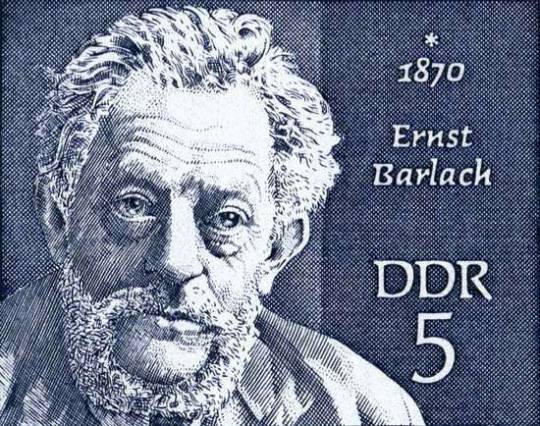
Ernst Barlach, from an East German stamp, 1970. Would he have been pleased with his legacy?
I remember receiving a story on the couch in my neighbors’ den — I was about 10 or 11 — regarding the final days of the war: a fellow member of the resistance had suggested replacing the Dannebrog with the flag of the Danish Communist Party, the DKP, an idea that had shaken my neighbor to his core. For him, resistance had been an act of preservation, a defense of the right to be distinctly Danish, and all that it entailed, in an increasingly international world. How the inability to return to a Denmark before the crimes of Nazism must have felt, I can only attempt to imagine. To this day, I am astounded by my neighbors’ apparent lack of burnout in light of what they sacrificed, their resilience in living out their ideals and inherited melancholia with me under an umbrella on the patio. It seemed that, for them, past and present far outweighed considerations for the future.
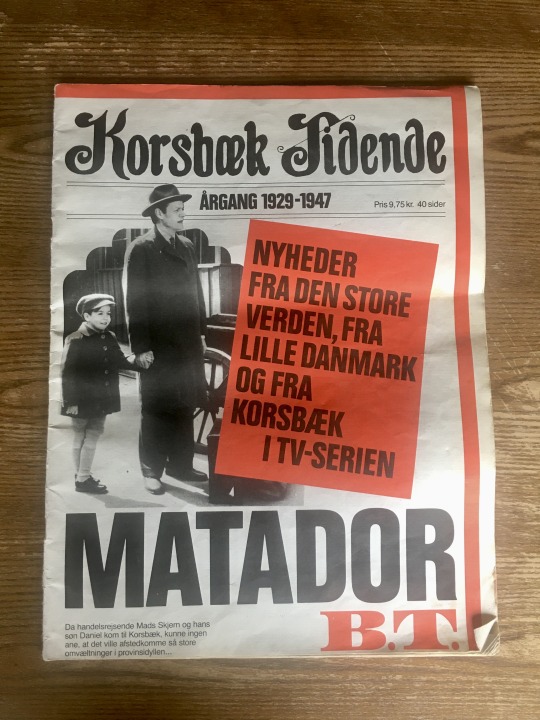
My copy of Korsbæk Tidende (Korsbæk Official Journal), an educational accompaniment to the popular Danish 1970′s and 1980′s tv-series “Matador” about a fictionalized Danish town between 1929 and 1947. I inherited this collection of real newspaper clips that informed events on the show from my neighbor — I assume he loved the show.
To an extent, I have inherited their idealism, an obsession with a bleak past used to check the present, an index of unwavering values to be accessed at any time. It is only through a sense of history that I’m able to make sense of the communicative power of images today, how calculated distortions of reality made ubiquitous through mass production can make us more empathetic, braver in the face of a not-so-distant future. It's a future that cannot be understood with the tools we have been given, that will almost upend our perceptions and unsettle us, a future that demands our bravery. More than ever my beloved neighbors ever could have fathomed, the possibility that our sacrifices will be bastardized in the name of another cause is unparalleled in the digital age. And even more than they experienced, we have the incredible opportunity, and challenge, to transplant our ideologies across ecosystems, upending heir original contexts.
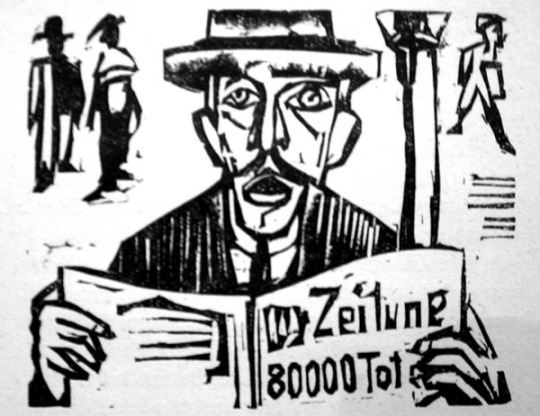
Simultaneous calls for universalism and individual freedom, the appeals of difference and homogeneity, the cogent argument of moral relativism against the call for a shared global narrative will, no doubt, continue to shake us in an era of unprecedented displacement and global climate change. Among other things, these challenges call for an art that, like the pervasive woodcut, infiltrates our purviews, and is attuned to the affect of contemporary life. It should carry with is a melancholic nostalgia, demand our empathy, blemish our idealized beauty.
If I limit myself to woodcuts, I'm reminded of the works of William Kentridge, Beatriz Milhazes, Leonard Baskin, Alison Saar, Irving Amen, Tony Bevan, Katsutoshi Yuasa, Assadour Bezdikian, Elizabeth Catlett, Lou Barlow, Leon Gilmour — I'm sure I'm missing countless others.
Retrospective Exhibitions on Käthe Kollwitz
Käthe Kollwitz, National Gallery of Art, Washington, D.C., 1992; Käthe Kollwitz: In Celebration of the 125th Anniversary of the Artist’s Birth, Galerie St. Etienne, New York City, 1992; Berner Kunstmuseum, Bern, Switzerland, 1946; Retrospective in honor of her 50th birthday at Paul Cassirer galleries, Berlin, 1917
Selected Bibliographies on Käthe Kollwitz
Knesebeck, Alexandra von dem. Käthe Kollwitz: Werkverzeichnis der Graphik. Band I & II. Bern: Kornfeld, 2002.
Prelinger, Elizabeth, ed. Käthe Kollwitz. Exh. cat. Washington, DC: National Gallery of Art, 1992.
Rix, Brenda D., and Jay A. Clarke. Käthe Kollwitz: The Art of Compassion. Exh. cat. Toronto: Art Gallery of Ontario, 2003.
Selected Bibliographies on Ernst Barlach
Laur, Elisabeth. Ernst Barlach: Sämtliche Werke, Werkverzeichnis I. Die Druckgraphik. Leipzig: E. A. Seemann, 2001.
Paret, Peter. An Artist Against the Third Reich: Ernst Barlach, 1933–38. Cambridge: Cambridge University Press, 2002.
Selected Bibliographies on Ernst Ludwig Kirnchner
Dube, Annemarie, and Wolf-Dieter Dube. Ernst Ludwig Kirchner: Das graphische Werk. 2 vols. Munich: Prestel, 1980.
Gercken, Günther, and Magdalena M. Moeller. Ernst Ludwig Kirchner: Farbige Druckgraphik. Exh. cat. Berlin: Brücke-Museum, 2008.
Krämer, Felix, ed. Ernst Ludwig Kirchner: Retrospective. Exh. cat. Frankfurt: Städel Museum, 2010.
Lloyd, Jill, and Magdalena M. Moeller, eds. Ernst Ludwig Kirchner, 1880–1938. Exh. cat. Washington, DC: National Gallery of Art, 2003.
Wye, Deborah. Kirchner and the Berlin Street. Exh. cat. New York: The Museum of Modern Art, 2008.
1 note
·
View note
Audio
(Literary License Podcast)
Batman: The Animated Series
See No Evil
Lloyd "Eddie" Ventrix is on the verge of losing his daughter, Kimberly (Elisabeth Moss), to his ex-wife, Helen, due to his past as a con artist. Determined not to lose Kimberly, Ventrix dons a suit, stolen from where he used to work while on parole, which grants the user invisibility but also becomes highly toxic and drives him insane. He poses as Kimberly's imaginary friend, Mojo, and planning to abduct her from her mother, while in a crime spree as an invisible robber. Batman must solve the mystery crimes and stop Ventrix, despite the fact that he cannot even see him.
Beware the Gray Ghost
Simon Trent, an actor best known for his past role as "The Gray Ghost", is on the verge of bankruptcy thanks to his declining career. To save himself, he sells off all of his Gray Ghost merchandise. Immediately afterwards, a series of bombings related to the old show begin to occur. Batman, having himself been inspired partly by the show to become the crimefighter he now is, goes to Trent for help, and they team up to put an end to the crimes, and also revive Trent's career.
Prophecy of Doom
Batman investigates a cult, called the Brotherhood, founded by the "mystic" Nostromos, after hearing about a number of stories from his colleagues about his ability to predict the future. Batman finds out that Nostromos is actually a con artist who was rigging near-fatal accidents to gain the confidence of Gotham's upper class citizens, and he must expose this ruse before it is too late.
Joker’s Favor
After a man named Charlie Collins curses at the Joker on the road for offensive driving, the Clown Prince of Crime corners him and intimidates him into doing him a "small favor". Two years pass, and the Joker finally decides how to use Charlie: to sneak a bomb into the Peregrinator's Club, where Commissioner Gordon is to give a speech at an award ceremony. Charlie, who merely has to open the door, is sceptical at first, but for the sake of his family, he reluctantly decides to obey.
We are joined by Mark Krawczyk, Host of The Spoiler Room podcast. You can follow his show or himself by going to the following websites:
https://www.specialmarkproductions.com
https://anchor.fm/spoilerroompodcast
https://twitter.com/SpecialMarkPro
https://www.instagram.com/SpecialMarkProd
https://www.tiktok.com/@specialmarkproductions
Opening Credits; Introduction (1.29); Amazing Design Advertisement (32.25); Episode One See No Evil (33.37); Episode Two: Beware the Grey Ghost (47.24); Episode Three: Prophecy of Doom (1:20.20); Episode Four: Joker’s Favor (1:45.57); Favourite and Least Favourite Character (2:34.15);Same Bat Time, Same Bat Channel (2:51.43); Closing Credits (2:54.37)
Opening Credits– Batman Animated Theme by Danny Elfman. Copyright 1992 Warner Music
Closing Credits: My Hero by The Foo Fighters. Taken from the album The Color and The Shape. Copyright 1997 Roswell – Capitol Records.
Original Music copyrighted 2020 Dan Hughes Music and the Literary License Podcast.
All rights reserved. Used with Kind Permission.
All songs available through Amazon Music.
#SoundCloud#music#Literary License Podcast#Batman The Animated Series#Batman#Kevin Conroy#Elizabeth Moss
0 notes
Text
Austrian Movies Masterpost
*Some of these are not actually Austrian productions, but have important cast or crew members who are Austrian. That is Austrian enough.
Classics and Must-See:
Echte Wiener – Die Sackbauer-Saga (Real Viennese - The Sackbauer Saga), 2008, Comedy, dir. Kurt Ockermüller. IMDB: 30 years after we saw the Sackbauers the last time, they have estranged from everyone. Only mother “Toni” tries to re-establish the old happy family. It is the first of two movie sequels to the Austrian cult series “Ein echter Wiener geht nicht unter”. Trailer, Trailer for the sequel
Das Fest des Huhnes (The Festival of the Chicken), 1992, Comedy/Mockumantary, dir. Walter Wippersberg. IMDB: A hilarious spoof on ethnological documentaries: an African TV team comes to the Austrian province to document the strange behavior of the natives. A movie that most students will watch in school at some point, ususally before they really understand and appreciate it, but it’s actually hilarious! Trailer
Hallo Dienstmann (Hello Attendant), 1952, Comedy/Musical, dir. Franz Antel IMDB: Musical comedy about confused identities. Music professor Godai dresses up as service worker for carneval when he accidentially gets a job to move luggage. He plays along when he falls in love with the luggage owner. Everything becomes complicated when the woman of his desire turns out to be the new teacher at the music university. One of Hans Moser’s most famous movies, also starring Paul Hörbiger. There are several others worth watching, especially if you like musical comedies. The song Hallo Dienstmann from the movie
Komm, süßer Tod (Come Sweet Death), 2000, Comedy/Mystery/Thriller, dir. Wolfgang Murnberger IMDB: Ex-detective Brenner wants to keep himself out of trouble but several murder cases and his ex-girlfriend Klara finally get him involved. But making decisions is not one his strengths. The first of four ‘Brenner’ movie adaptions to the novels by Wolf Haas. It’s also co-written by Josef Hader, who also plays the main character Simon Brenner. Trailer, Trailer to sequels: Silentium, Der Knochenmann, Das Ewige Leben
Liebe (Amour), 2012, Drama/Romance, dir. Michael Haneke IMDB: Georges and Anne are an octogenarian couple. They are cultivated, retired music teachers. Their daughter, also a musician, lives in Britain with her family. One day, Anne has a stroke, and the couple’s bond of love is severely tested. Depressing, like any good Haneke movie. Watch it if you’re in the mood to have your week ruined. However, it was nominated for two Oscars and won one, and is worth a watch! Trailer
Müllers Büro
(Müller’s Office), 1986, Comedy/Crime/Musical, dir. Niki List IMDB: Private detective Max Müller and his assistent Larry try to solve a crime but find themselves in strange bars and women. This is an absolute must-watch and one of my favourite movies in general. The humour is on point, it’s very quotable, and the musical acts just fit in perfectly. Also, we get to see a young Andreas Vitasek! Trailer
Muttertag (Mother’s Day), 1993, Comedy, dir. Harald Sicheritz IMDB: A satirical take on the life of a family in a public housing complex in Vienna as they prepare for Mother’s Day. Quotable, iconic, hilarious, somewhat disturbing - an Austrian classic! Trailer
Sissi, 1955, Comedy/Drama/History, dir. Ernst Marischka IMDB: In the first of a trilogy of movies about Elisabeth “Sissi” of Austria, the young vibrant princess catches the eye of her sister’s fiancé, Emperor Franz Josef. The movie that made Romy Schneider a world star. Maybe not for everyone, but every Austrian should watch it at least once! Trailer
Die Wand (The Wall), 2012, Drama/Fantasy/Mystery, dir. Julian Pölsler IMDB: A woman inexplicably finds herself cut off from all human contact when an invisible, unyielding wall suddenly surrounds the countryside. Accompanied by her loyal dog Lynx, she becomes immersed in a world untouched by civilization and ruled by the laws of nature. This movie is majorly fucked up. There is no other way to say it. Watch it if you want to feel a mixture of shock, disgust, and depression. Trailer
Das weiße Band (The White Ribbon), 2009, Drama, Mystery, dir Michael Haneke IMDB: Strange events happen in a small village in the north of Germany during the years before World War I, which seem to be ritual punishment. Who is responsible? Another Haneke movie, you can never go wrong with that. And it is an important movie about Austrian and German history. Trailer
We Feed the World, 2005, Documentary, dir. Erwin Wagenhofer IMDB: A look at how the world’s food is produced and how mass production changes the environment and the lives of people. This is the movie that almost everyone watched at school at some point. Trailer
Recent Movies:
Die Migrantigen (The Migrumpies), 2017, Comedy, dir. Arman T. Riahi IMDB: For a TV documentary, the two unemployed friends Benny and Marko pretend to be petty criminals with immigrant background until the coin flips and reality turns against them. This movie is hilarious and offeres a different perspective on the much talked about issues of immigration and integration. Trailer
Wilde Maus (Wild Mouse), 2017, Comedy/Drama, dir. Josef Hader IMDB: When Georg loses his job, he conceals the fact from his younger wife Johanna, who wants a child with him. Instead, he embarks upon a campaign of revenge against his former boss and begins to renovate a roller-coaster with an old school friend. It is a typical Hader movie. Which means it is a bit depressing, but in a funny way. It’s very enjoyable, and the soundtrack only adds to that. Trailer
Siebzehn (Seventeen), 2017, Drama, dir. Monja Art IMDB: Paula, an above-average intelligent student, is in love with her classmate Charlotte. At the same time she feels permanently provoked by dissolute Lilly to challenge her limits. This movie is cute. I’d bet that the average tumblr user would greatly enjoy it, and I did too. I mean, I didn’t enjoy it just because wlw romance, but it definitively was a plus! Trailer
Personal favourites and movies I just need to mention:
Bad Fucking, 2013, Comedy, dir. Harald Sicheritz IMDB This movie is inspired by the name of the real Austrian Village Fucking. It is about the fictinal tourist resort Bad Fucking that mainly attracts people with its unique name. To be honest, the trailers looked more promising than the movie really was, but nevertheless, it was entertaining. My highlight was Michael Ostrowski, also known as “Franzi” from Vier Frauen und ein Todesfall, as mayor. Trailer
Funny Games, 1997, Drama, Horror, dir. Michael Haneke
IMDB: Two violent young men take a mother, father, and son hostage in their vacation cabin and force them to play sadistic “games” with one another for their own amusement. My favourite Haneke movie. I’m not a huge horror fan, but that movie just struck a nerve, somehow. Make sure you watch the 1997 original, not the American 2007 remake. Trailer
Im Keller, 2014, Documentary, dir. Ulrich Seidl IMDB: A documentary that reveals what its subjects do in their respective basements. If you think that documentaries are boring, watch this one. The movie is many things, most of all distrubing and, I don’t want to say “gross”, because we’re talking about real people here, but it kind of is, but it is not for a second boring. Trailer
Feel free to add more if I missed them!
#austria#movies#movie recommendation#karl merkatz#echte wiener#andreas vitasek#müllers büro#josef hader#im keller#ulrich seidl#brenner#sissi#romy schneider#original post#muttertag
206 notes
·
View notes
Note
Hello, Glass! I hope you haven't answered it already, but I'm new to Elisabeth das Musical, and I really wanted to get to know it. Do you have any directions? Like a good cast to start with, or a good video to look up after... Any good tips also in what to run away from? :P My tastes are alike yours, so I trust it. Thank you very much!
Well, if you haven’t already, definitely check out the 2005 proshot video of the Vienna production. There’s a version of that which comes with (fan-made) English subtitles, which can really help you understand what’s going on if you don’t know German. The YouTube version of it got taken down, but I believe @cosetteskywalker has a copy of it.
Anyway, if you have watched it (which many fans have - for a lot it’s the gateway to the musical), then you can check out some of the following versions. The cool thing about Elisabeth is that there’s a ton of proshot versions floating around of many different productions, so it’s pretty easy to find a decent video with a good cast. Here are some recommendations:
August 29, 1992 Viennavideo - Dress rehearsal, so there are a couple of incidents that end up stopping the show, but otherwise a good look at how the show originally was envisioned. (Note: it was a lot darker.) Uwe Kroger and Pia Douwes are also wonderful here, some of my favorite interpretations.
1999 Scheveningenvideo - I haven’t watched the Dutch production as much as I should have, but this video is a pretty good look at it, and is proshot like the above. I’ve heard some pretty good things about Stanley Burleson’s Death and the production as a whole, and it can also lead into…
January 13, 2002 Essenvideo - I don’t know if this was professionally shot, but it was filmed with a tripod by someone in the audience, so video quality is great. Since this was Pia Douwes’s last as Elisabeth (in this production; she comes back several more times), the audience energy is ridiculously high. Also a good introduction to the Essen production, which was heavily inspired by the Dutch production in many ways but also went off in its own, occasionally kitschy, direction in others.
September 17, 2006 Stuttgartvideo - I know I’ve been drowning you in videos of Pia Douwes, but this is the last and it’s for a somewhat unnoticed production: the Stuttgart production, which was an interesting mix of the Essen and Vienna revival productions. This was an audience recording but was also the last performance, so audience energy is very high. (They start waving glowing sticks around towards the end.)
March/April 2009 Antwerpvideo - Yet another proshot for the cast, beautiful quality and great cast overall. It also gives you a look at the staging that was used again for the German tours and 2012 Vienna revival; I greatly dislike it, but I think it’s worth seeing it at least once.
August 25, 2013 Seoulvideo - The Korean production was a funky mix of almost every production that had come before it, and this is probably the most common video of it. It features Kim So Hyun as Elisabeth (a former Christine from ALW’s Phantom and really cute) and Kim Junsu, who gets an unusual amount of focus from the filmer due to the fact that he’s a kpop star. The latter is great if you’re a kpop fan (like my sister) but a tad annoying if you’re just trying to enjoy a bootleg of the musical (like me).
Any Takarazuka video - Just about all the Takarazuka videos are proshot. The 1996 one is interesting for “historical purposes” to see what the original Takarazuka versions envisioned (e.g. an Elisabeth who is very romanticized and “lacking a brain and spine”, according to one viewer). The 2005 one with Ayaki Nao and Sena Jun is probably one of the most common versions though, and has a Death and Elisabeth closer to the interpretation used in the European productions.
Anyway, so that’s a pretty general overview; I was focused on getting you clear, common videos to see the different stagings and productions worldwide, though I admit I left off a few due to lack of knowledge (such as the Toho and Hungarian productions). It’s such a great musical though, and I really hope you enjoy exploring it!
47 notes
·
View notes
Text
where: euphemiasburg

Die königliche Domäne von Euphemiasburg (The Royal Domain of Euphemiasburg, or simply, Euphemisburg) is the previous official residence of the monarch of Mecklenburg. Built in the woods east of Bad Doberan, and west of Rostock, construction began in April 1922 after three years of planning and was completed in August 1936. It was one of the largest public works projects of the time and employed over 10,000 men and women (with over half of the workers being First World War veterans). Euphemiasburg is named after Euphemia of Sweden, an ancestress of the House of Mecklenburg, who died in 1370.
King Heinrich Ludwig I, and his wife Queen Karola, and their two children, Crown Prince Paul Friedrich and Princess Marie Elisabeth, moved into the palace in March 1932 after the majority of construction was completed. Following the Nazi invasion of 2 June 1937, Paul Friedrich and Marie Elisabeth fled to Denmark while their parents remained in Mecklenburg. The King and Queen were moved to Schweriner Schloss a couple of years later where they remained for the rest of the war.
Due to the Soviet occupation of the western regions of Mecklenburg, including the former capital city of nearby Rostock, Euphemisburg wouldn't become a royal residence again until the 1970s when the children and grandchildren of King Paul Friedrich II and Queen Thyra required residences of their own. Euphemiasburg's size was easily able to house them.
Following the reunification of Mecklenburg in 1990, the royals soon vacated the palace, moving into smaller homes previously inaccessible due to the Soviet occupation. In 1991, King Wilhelm Franz I decreed that Euphemiasburg would become the traditional residence of the Crown Princes and Princesses of the realm, the first being his daughter, Karolina Augusta.
Karolina Augusta would never occupy the palace. Her father died on 20 January 1992 and she ascended the throne as Karolina Augusta I of Mecklenburg, aged three.
Queen Eleonora opened the palace and grounds to the public in 1993. The royal domain is open to the public almost year round, only closed when in use by the royal family.
Euphemiasburg remains in royal use, both officially and unofficially. The Thanksgiving Service and the New Year's Honours Banquet are hosted at the palace each year on the Sunday after Whitsunday. The Kingdom Day Honours Banquet is hosted at the palace each year on the first Sunday of October. The House of Mecklenburg hosts members of the Royal Families of Denmark, Norway and Sweden each July for Scandiburg Weekend at the palace. The family often holds large family gatherings at Euphemiasburg due to the palace's large number of suites. These include weddings, birthday parties, and anniversaries. All members of the Royal House and Family of Mecklenburg are baptised at the nearby Doberan Minster and post-baptism celebrations are held at Euphemiasburg. State visits do not usually include events at Euphemiasburg.
The main palace is situated in the middle of a man made island, surrounded by canals. There are two mews wings flanking the south facade of the palace. The land slopes down after the palace, with cascades and a tiered English style garden, culminating in a large man-made lake. There are two smaller canals bordering a formal French garden and flanked by an orangery and a greenhouse. Further administration buildings were planned but never built. There are sub-basements tunnels connecting the mews buildings to each other and the main palace.
Euphemiasburg is the largest royal palace in the world by floorspace (approx. 269,375 square metres for the main palace structure - not including the sub-basement tunnels), and by volume (approx. 2,208,875 cubic metres for the main palace structure - not including the sub-basement tunnels ). For comparison’s sake, Buckingham Palace has a floorspace of 77,000 square metres. The north and south facade of the palace is 270 metres across and the east and west facades are 340 metres across.
While criticised for its vast size, Euphemiasburg was originally intended to be a multigeneration palace. When planning began in 1919 it was assumed that Schweriner Schloss and Schloss Ludwigslust would remain in the possession of the former Grand Duke’s family in perpetuity.
Keep reading for more information and to view “images” of this fictional estate (no spoilers).

Exterior
The building's exterior is modelled on Frederiksborg Castle and Rosenborg Castle of Denmark, known for their red brick exterior and stepped gable roofs. Red brick Gothic buildings are common in Mecklenburg, Euphemiasburg’s exterior has Renaissance and Baroque influences. Euphemiasburg has sixteen towers.

Interior and “Internal” Gardens
The main building is made up of four main floors, plus a basement and attic. The ground floor contains the Royal and Ambassador Staircases, loggias, long galleries, offices, staff areas, royal and guest suites, the chapel and visitor restrooms. The first floor, the primo piano nobile, contains further royal and guests suites, the throne hall, ballroom, theatre, the main library, long galleries, and state and semi-state rooms. The second floor, the secondo piano nobile, contains more royal and guest suites, smaller libraries, long galleries, and semi-state rooms. The third floor contains even more royal and guest suites, semi-state rooms, offices and staff areas. The basement has the kitchens, staff areas, storage, offices, a gym and swimming pool (below the ballroom), and a surgery (below the theatre). The attic has staff bedrooms and common areas, and further storage.
The interior is modelled on the great Renaissance and Baroque palaces of Germany, Austria, Spain, Italy, France, Russia, Denmark, Sweden and Poland. Everything, furniture and fixtures included, in the palace was built brand new, though following older styles of design, creating a sense of faux history within the building.

There are fifty-five state rooms, and eighty-eight semi-state rooms within the palace. These include receiving rooms, smaller dining halls, great halls, long galleries, libraries, the ballroom and the throne hall. The ballroom is used to host gala and family dances. The throne hall hosts gala and family banquets. The throne hall was previously used as a place to receive ambassadors and give investitures, but since 1945, the throne room of Schweriner Schloss has been used for these purposes.
There are sixteen large one bedroom royal suites, forty-eight three bedroom royal suites for members of the Royal House and Family, and sixty-four two bedroom guest suites and 100 one bedroom guest suites for visitors. Prominent guests stay in one of the large one bedroom royal suites. A maximum of 648 royals and guests can occupy the palace at one time. None of the royal or guests suites are open to public viewing. The semi-state rooms near the guest suites are used as common areas for the guests. There are 400 staff suites but the total number of full time staff working on the estate numbers around 100, expanding to 200 during official and unofficial events.

In addition to the grand Royal and Ambassador Staircases, there are dozens of smaller formal staircases, staff staircases, and formal and staff elevators. There is one great library and several smaller libraries through the palace.
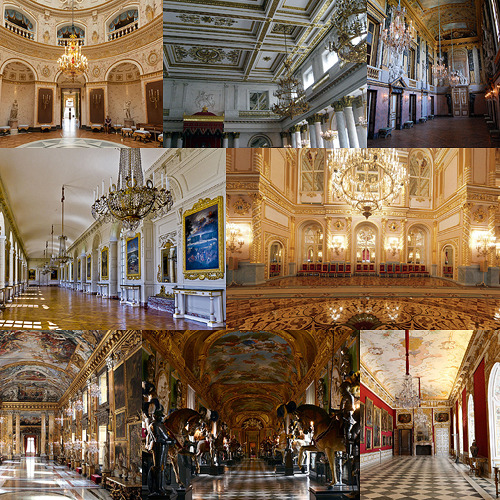
Over half of all paintings and portraits in the palace were commissioned after 1915 and it is the eventual home of nearly all modern royal portraits of the House of Mecklenburg. The crown jewels, and other treasures owned by the family, are on permanent display in Euphemiasburg’s museum wing. Euphemiasburg is well known for the quality of its temporary exhibits, having in the past hosted collections from the British Museum, the Royal Collection, the Louvre, the Palace of Versailles, as well as jewellery collections from Cartier.
There are three courtyards, a large central courtyard, and two smaller, glass covered courtyards. The central courtyard is laid to stone and gravel. The glass covered courtyards act as atriums to the guest and royal wings of the palace.
The theatre is used more often as a cinema. Plays, operas and concerts are rarely held in the palace.

The palace chapel has a seating capacity of 400. The crypt underneath the palace chapel is the traditional burial place for members of the Royal House and Family of Mecklenburg. The monarchs and their spouses are interred in elaborate tombs, while other members of the family are buried beneath slabs in recesses of the crypt. The palace chapel is open to the public when the rest of the palace is and conducts regular Sunday services for visitors and staff. The royal crypt is only open to the public on the birth and death anniversaries of the entombed. As of 2014, there are nine people buried in the crypt.
There are four "internal" gardens, named for each corner wing of the palace. The gardens are on the ground level and are accessible on the ground floor by doors in the suites and corridors, and on the first floor by an internal balcony and staircases. These gardens are simpler in design and are never accessible to the public as several royal and guest suites open out to the gardens. It is however possible to view the gardens through several first floor windows and glass doors.
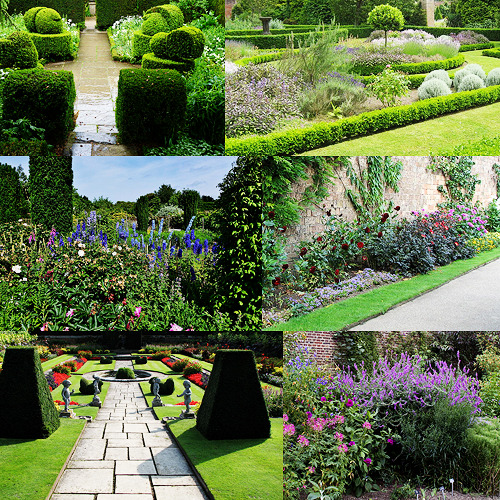
Grounds and Outbuildings
On the approach to the palace island are two gardens, the formal South and North Carriage Gardens, dominated by fountains, statues and hedges. The Spanish inspired Ambassador Garden welcome visitors to the palace complex, and the English inspired Royal Garden bids them farewell as they leave the palace island.

Cross the Italian inspired Terrace Garden, then the central canal and descend through the English inspired Tiered Garden to the lake below. Across from the semi-circle lake is the French inspired Formal Garden, which is bordered on the east and west by further canals and an orangery and greenhouse.

There is also a Walled Rose Garden and Fountain Garden to the west of the palace, and a Walled Kitchen Garden and Statue Garden to the east. The Kitchen Garden helps feed the occupants of the palace and the patrons of the restaurant and cafe.
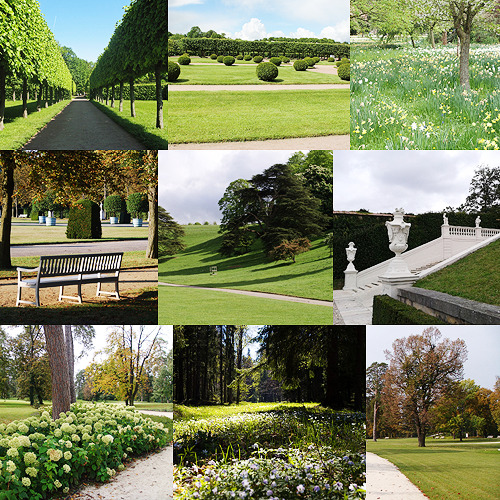
There are several copse of trees and meadows throughout the lawns and the entire estate is surrounded by a thick border of trees and shrubs. This tree border, and the twelve foot brick wall surrounding the domain affords its occupants complete privacy.
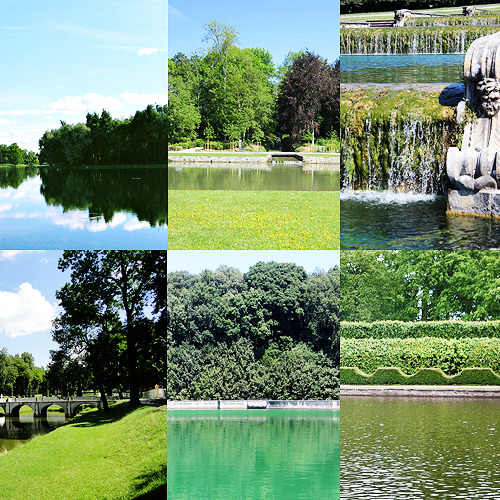
Most of the grounds and “external” gardens are accessible to the public. The only gardens not accessible to the public are the gardens between the canals and the royal and guest suites as those have direct access to the gardens. These canal-side gardens are afforded extra privacy due to walls and hedges blocking the view.
The two mews buildings are each made up of three main floors, plus a basement and attic. The west mews building is a garage for royal and staff cars. The east mews building is a stable for royal and staff horses. The domain grounds are patrolled by mounted security officers. The ground floor of each mews building are made up of the garages and stables respectively. The first floor contains offices, while the second floor and attic are used as staff accommodation. The basement contains storage and further staff common areas. The mews buildings are not open to the public (because the cars are normal cars and the horses are best left alone).

Within the Elisabeth Sybille Orangery (named for King Heinrich Ludwig I’s mother) is a restaurant which caters to both the public and royal family, and a small concert hall (which sometimes houses temporary exhibits). Inside the Amalie Greenhouse (named for Queen Karola’s mother) is a cafe, which also caters to both the public and royal family, and a swimming pool, which is never open to the public. While still rather grand, the Orangery and Greenhouse consist of only a basement and ground floor.

click here for higher resolution with more details
The site map of the Royal Domain of Euphemiasburg. The site map is entirely to scale (except for the visitor and staff car parks - I'm not sure how big car parks are supposed to be). There a dozens of interconnecting paths and riding trails on the estate not featured on the site map. The sections and wings of the palace are labelled by the predominate feature of that section of wing, it doesn’t mean that no other type of room can be found in that part of the palace. For example, above the Royal and Ambassadors Staircases are semi-state rooms.
The royal domain covers 502.85 acres or 203.5 hectares. For comparison, the Palace of Versailles’s royal domain covers 2,014 acres or 800 hectares.
Access and Visitor Information
On days the royal domain is open to the public, the grounds are accessible from 9 am to 6 pm, while the buildings are accessible from 10 am to 5 pm. No paying guests are able to take their car further than the visit car park, but a shuttle bus is available every ten minutes to ferry visitors to and from the central courtyard. Entry to the palace is through either the Royal Staircase or the Ambassador Staircase.
Photography is allowed throughout the royal domain. Flash photography is prohibited in the palace’s interiors.
Entry is €15 for adults, €10 for children, students and seniors. Entry is all inclusive. There are free guided tours of the interior and grounds every hour.
Euphemiasburg enjoys a steady flow of visitors year round, but is considered to be Mecklenburg’s hidden royal gem.
All photos are used as inspiration and to create the general feel of this fictional palace. All images are taken from Wikipedia Commons or Google Images (because Wiki Commons doesn’t have good images of kitchen gardens for some reason). I did not keep track of which real life palaces the pictures are from, but you might recognise some of them!
3 notes
·
View notes
Text
Wither and Wilt
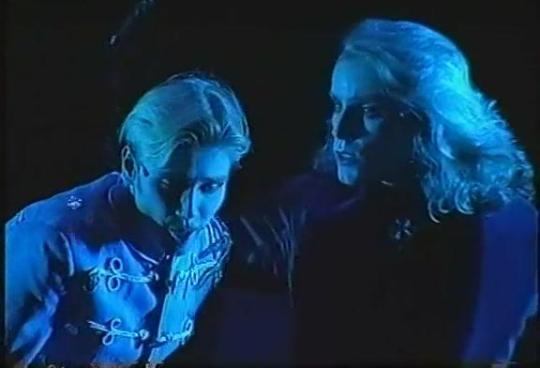
Pairing: Rudolf von Österreich-Ungarn | Rudolf Crown Prince of Austria/Der Tod | Death
(as in Rudolf has a crush on Der Tod, it’s up to you whether Der Tod truly returns his affections, I wrote it that he does truly like Rudolf but you’re welcome to interpret it anyway you like)
Words: 2032
Rating: General Audiences
Tags: Anxiety | Self-Esteem Issues | Self Confidence Issues | Fluff | Slow Romance | Pre-Slash | Pre-Relationship | Genderfluid Character | Pansexual Character | Bisexual Character | Bisexuality | Bi-Curiosity | Implied/Referenced Homophobia | Period-Typical Homophobia | a little mention of it | Flowers | Flower Crowns | Vignette | Drabble | m/m f/m and other tags because death is genderfluid
Read on Ao3 @ emptymasks. I can’t put the link or tumblr blocks the post.
Notes: Death is based on Uwe Kröger's Der Tod from the original 1992 production, with a little bit of inspiration also drawn from the Hungarian production's A Halal. You could probably picture anyone as Rudolf, I kept imagining Andreas Bieber and Lukas Perman's portrayals while writing it. Death is genderfluid in this because 1. I'm genderfluid and I see Uwe's death as genderfluid and that representation matters a lot to me , and 2. Uwe literally descried his Der Tod as fluid in gender and sexuality. So there's your canon genderfluid, pansexual Death.
So... you will most likely laugh when I say how i got the idea for this fic, that after having several WIP's for various Elisabeth fics, I ended up writing this because, right, I was playing Animal Crossing and of course I've made several of Uwe's and Máté's Der Tod costumes for me to wear in the game and while wearing my 'Uwe Tod Jacket' I put a white wildflower in my hair and literally had to leave the game so I could right this because the idea came straight away.
It was unusually sunny for April. Sunlight peaked in out of the tree branches of the gardens, casting speckles of stained glass windows onto the grass. The many flowers and shrubs only sought to pair with the weather and make the most pleasant day of the year so far.
It was the weather that had driven Rudolf outside. He loved the fresh air, loved feeling it on his skin, despite how his family would prefer him cooped up inside. (Though they always seemed to want him inside when he wanted to be outside, and outside when he wanted to be inside. Forever wanting for him whatever he wished for the least.) He'd forgone a jacket or coat, allowing the breeze to flutter against his white shirt that billowed out as he moved.
A glimpse of sunlight and a walk alone through the gardens was one of the few pleasures in life Rudolf had at the moment. One of the few things that was just his. He was fortunate that the spring air hadn't coaxed anyone else outside and he got to enjoy all of it to himself.
Although... there was one person who couldn't damper his walks, only increase the joy Rudolf found on them. And as if he'd been waiting for Rudolf to think of him, the wind turned bitterly too cold for a moment and a pair of footsteps were at his side.
They didn't speak for a while. They didn't need to. Rudolf found comfort in his old friend simply being by his side, he needn't do anything. They walked in tandem until they came to a small clearly populated by wildflowers and Rudolf could feel the wind high on his cheeks.
"It's beautiful, isn't it?" His voice was quiet, as if afraid it was a stupid thing to say.
"Quite," Death's reply was soft and it called to Rudolf like a siren and he turned his head to find Death wasn't staring at the clearly, he was simply starting at Rudolf.
Rudolf felt his mouth part and cheeks flush and he didn't know how to prolong the moment and he definitely didn't want to say anything that would cause Death to leave. He walked a few paces more.
"Would you like to sit with me for a while? It doesn't have to be long, I know you're always busy, and you shouldn't feel like you have to spend any time with me and..." Rudolf trailed off as Death sat down at his feet.
"I assure you, Rudolf, I wouldn't be wasting my time by spending it with anyone I like."
"Oh..." He winced at how stupid he sounded. "Alright then."
He sat down opposite Death, not close enough to touch, afraid of what would happen if they did but also longing to know. Death turned his head and looked out across the gardens and Rudolf took the chance to stare.
Out of all the times Death had come to him, only a couple of them had been outside of his bedroom. (Not that that had any implications, he pleaded at his heart). The few times they'd been outdoors had been at night or in the evening, the light low and dark, Death rivalling the moon with his glow.
This was the first time he'd ever seen Death in the daylight.
Rudolf felt like he had to hold his breath as he gazed. The sun made Death's hair a more buttercup yellow, more colourful than he'd ever seen it, and only highlighted how pale his skin was even more. Where human's skin would darken a red colour, his seemed to be... blue. Rudolf thought about how impossible that was, but this was Death. For all he knew Death's blood was blue, if he even had blood at all. Light gleamed off his skin and it almost looked as if there were tiny, intricate crystals along his cheekbones, glistening and shimmering.
He didn't know what Death could be looking at, and realised Death very well might not be looking at anything at all. He may just be content to let Rudolf stare. And so Rudolf tore his gaze away and looked down. The more colourful flowers had given way to ones of pure white and Rudolf plucked one up with an idea. A stupid, childish idea that Rudolf found himself acting on.
“Here,” Rudolf reached up, the pale white flower trembling in his hand, and tucked it behind Death’s ear. “White looks nice on you.”
Death’s face cracked for a second, broke out of its usual cold and calm expression into one of quiet shock, and then the smallest smile at the corner of his mouth.
“Why, thank you, my little prince,” He spoke and Rudolf thought about how often Death’s voice sounded like it was only for him, as if everything Death said to him was their own little secret. A black gloved hand reached towards the bundle of white wildflowers in Rudolf’s hands. “Why don’t you match with me?”
Rudolf’s hands jerked back and Death’s face morphed back to looking cold. He tilted his head. Always so curious about humans and their funny little worries.
The cold gaze lingered on Rudolf, he could feel it baring down on him as he looked at his hands.
He hadn’t meant to react as quickly and sharply as that. Should he explain himself? He wished sometimes Death would just ask him things more often, but Death was so content to just sit and wait until Rudolf was ready to share and that just caused more anxiety to swirl around in Rudolf’s stomach. What if Death wasn’t really waiting until he was ready to speak? What if Death just didn’t want to know and if Rudolf opened his mouth he’d just be bothering another person, disappointing another person, words and ideas tumbling out of his lips before he can stop them, his passion seen as immaturity and naivety. What if Death was merely humouring him, and as soon as Rudolf spilled his heart all over porcelain skin and black velvet, he was met with jeers; His mother sat on her throne as Death coiled around from behind her and leaned into her ear, lips brushing against skin, heat and temptation and desire pouring out of his mouth as she looked down on him in scorn.
A sudden coldness brushed against his hand, then slowly pressed down and Rudolf fought the urge to shiver.
Death’s hand laid bare against his own.
He knew of course, that all that was ever under those gloves were hands, just ordinary hands (well ordinary looking hands), but he half had expected something monstrous. Perhaps gnarled or scared skin. Perhaps a blue glow that seemed to linger around Death just as he would enter or leave his visits. Perhaps claws.
Instead pristinely manicured nails decorated the soft, albeit cold, skin that rested against him. Death was a prideful being. He still had his head slightly tilted, eye’s deciphering a puzzle.
“This is about more than you not wanting to wear flowers in your hair…?” Death said it like he himself quiet sure he was asking a question.
“It’s…” Rudolf felt like he’d surfaced out of water and had the urge to take gasping breaths. “It’s not that I don’t want to… It’s… It’s not something a man does.”
“According to whom?” Rudolf forced himself to keep still, even as he thought he heard Death almost chuckle.
“Grandmother said-”
“Oh, your family and their silly, little ideas-”
“Grandmother said that men don’t wear flowers. Flowers and pretty things are for women and girls to wear and for men to admire.” Rudolf was surprised at how he continued to talk over Death. From anyone else he would have received a reprimand, but Death looked proud.
“…You’ve put one in my hair.”
“Yes, well, to be honest I’m never really quite sure if you’re a man.”
He didn’t mistake Death chuckling at that.
“I’m never quite sure of that myself, either. I find it tends to change with the wind," And Death got Rudolf to chuckle in return. "So, tell me,” He leaned forward and got that glint in his eyes as if he’d just spotted an opportunity to gain something, some new piece of information or emotion. “Is it wrong for me to be wearing it? Or are you seeing me as a pretty woman to be admired by your masculine gaze?”
Rudolf could feel his face heating up.
“Or perhaps, my dear prince, you don’t think it’s only women who should be admired?” Rudolf tried to pull his hands back, but Death had a firm grip on them. “It’s alright, it’s quite alright. I’m truly flattered. And, let me tell you this because I think you need to hear it, it’s perfectly normal. There’s nothing wrong with it. Your grandmother’s opinions on the other hand… Who is she to say what you can and cannot wear? My future emperor,” Death reached out with his gloveless hand and brushed his fingers over Rudolf’s cheek and he shivered. “Only you are in charge of what you do, how you choose to dress, and who you choose to be.”
He held Death's gaze for what felt like an eternity. Everything seemed to be waltzing around them as they themselves where held captive in their own dance, twirling as the world fell down around them.
Death seemed like he was waiting for something. Rudolf sat, frozen, and Death retracted his hand.
"I think you'd look rather fetching..." Death murmured as if talking to himself, but well aware that Rudolf could hear him. His fingers skated over the flowers standing proud from the ground, ghosting over them but never touching. The flowers almost seemed to bend out of his way, as if they knew who he was, what he could do.
Their eyes met with a challenge in Death's that said 'pick one'. Rudolf's hands moved blindly as he wrapped his fingers against what he hoped was a flower and tugged. He'd thought his hands had been shaking when he tucked one behind Death's ear, but it was nothing compared to how much they were quivering now.
"Will you...?" Rudolf held his hands forward and Death hesitated for a moment, fingers twitching. Was there a reason why he hadn't just picked one himself and placed it in Rudolf's hair? Rudolf knew what Death's kiss could do, and he'd wondered if the reason Death wore gloves was the same. But he'd just been touching Rudolf, and he was still alive.
Death's eyes flickered between the flower and Rudolf's eyes, before he leaned forwards. He picked the flower up carefully by its stem and slid his finger and thumb together, causing the flower to twirl around. He watched it with a curiosity Rudolf would have described as 'child-like' if it wasn't Death he was trying to describe.
He was almost mesmerised by the spinning of the flower that he almost didn't notice it at first. The flower was drooping ever so slightly. He thought perhaps Death's group was just squashing its stem, but it seemed to keep drooping and drooping. Death moved his hand and Rudolf followed with his eyes as the flower was drawn up to Death's face.
White petals brushed over cold lips.
The flower yielded.
It furled in on itself and faded, the top of the stem turning a pale, rusted brown. Death's hand moved and Rudolf was amazed that the petals didn't fall out. Perhaps somehow Death was keeping them in there? Rudolf expected cold brush against his ear, but none came. Death was still moving, picking and plucking more flowers, and as he wove them together they cried out and wilted. He closed up the chain and held it up, inspecting it, before shifting his gaze back to Rudolf.
Death raised himself up into his knees and placed the circle dead flowers on Rudolf's head.
"There," Death said. "A crown fit for an emperor. My emperor."
There was a sound like the ghost of a snapping branch and Death turned his head.
And then he was gone, and Rudolf was alone, frozen as the petals started to fall from his head.
#elisabeth das musical#der tod#elisabeth the musical#elisabeth musical#todolf#crown prince rudolf#mywriting#mine
19 notes
·
View notes